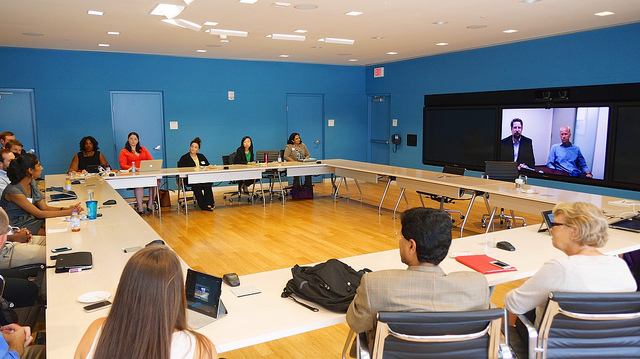My partners and I spend a lot of time writing about how difficult it is to be a family successor to-be or child working for a parent. We also have many articles detailing how business owners can communicate more effectively with employed family members so they can have positive working relationships while protecting their familial relationships. We've explained how important it is to establish boundaries so that work issues stay at the office to provide quality family time at home.
What we haven't spent enough time on is recognizing how tough it is to be the spouse of an ambitious, successful and highly driven business owner. Typically, although not always, these roles are cast stereotypically, with the husband running the business while the wife holds their personal lives steady raising the children and managing the household. For the sake of simplicity, we'll talk in terms of the stereotype, but the description works with the gender roles reversed.
The women are dynamic, intelligent, educated, assertive people - many left rewarding careers to care for their families so their husbands could fully concentrate on building a substantial family business. They have typically not been included in much of the financial and business-related decision making because they were not actively involved in the business. When families are young, this makes a lot of sense as each spouse is fulfilling a necessary role to provide and care for a growing family and business. The wife protects her husband from family distractions and worries so he can concentrate on building a business legacy and their financial security. The husband protects his wife from the day-to-day business challenges, makes sure there is enough money to run the household and generally learns it is easiest not to burden her with worrisome details of how he manages the business checkbook. However, when it comes to making the critical decisions that will provide for the financial stability of your children's future and your financial security, you can bet it is important for both spouses to be involved and participate in the discussion if you want to maintain family harmony and have a smooth transition for the next generation.
The Disenfranchised Spouse
By the time we are engaged to develop and implement a business succession and estate plan, the business owner's children are usually grown, working in the business and building their own families and the wife/mom is busy being a grandparent, participating in all kinds of civic/community/church activities and planning their next vacation trip. The husband/dad is still running the business and making all of the financial and business decisions.
On the surface, the couple is solid, dedicated to supporting each other, and wants to provide for each other in their declining years. But deep down, there is usually a woman who feels disenfranchised and fairly clueless as to how the business will provide for her personal financial security in the event she outlives her husband. When advisers bring documents for her signature, this is her one time to be able to voice her opinion, take a stand and even hold up progress if she feels uncomfortable with any aspect of the process. She is told not to worry, that she will be provided for - but how and who will she have to turn to after he's gone? Her children? The managers? The family attorney? Not likely.
We have seen women known to be gentle, supportive and trusting change when it comes to protecting her financial security and whether she will have to rely on someone else running the business or get her monthly allowance from her children or, even worse, a banker.
Re-Engaging Your Spouse
If you haven't both been involved with your estate and succession planning team, it is likely you may be experiencing some challenges -- perhaps your progress has even come to a standstill, and there may need to be some discussion on this topic before you can proceed any further. What are some of the key factors to make sure that when you are ready to begin your estate or succession planning that you will be comfortable with the people and decisions that must be made? Here are some helpful tips to keep in mind:
- Never think that protecting your spouse from the truth is being helpful. It indicates you don't think she will understand, that she will overreact or that she is weak. None of these assumptions demonstrate an appreciation for her inner strength, intelligence and sensitivity to your concerns. Additionally, it prevents your closest, most trusted ally from being able to be part of the solution.
- Make sure your spouse knows and appreciates the key players you depend on each day to run and care for the business. If all she ever hears is your grumbling about a family employee's ineptitude, it is highly likely that she will not feel very good about that successor's ability to manage the business in your absence. The same goes for complaints about any other manager or adviser who is critical to your business stability.
- When putting together your adviser team (estate attorney, accountant, succession planner), make sure you do the choosing and subsequent meetings together. Interview prospective members of this team together -- you both need to feel comfortable with people who are going to help secure your family's legacy and financial future. There is nothing worse than a business owner who says his spouse doesn't need to be included in the discussions because she isn't involved in business operations. It is amazing what kind of insight we get from spouses -- about family, employees and managers, and about how their husbands are being affected.
- Just because your spouse is not an active employee in the business does not mean she is not your partner in every sense of the word. Every decision you make, every success or failure you experience, is shared by your spouse. When you are stressed, so is she; when you celebrate success, so does she. Why then, wouldn't you consider involving her in decisions that will ultimately affect her, too? You don't need to discuss every operational decision made each day, but it is important to share the strategically important ones that will affect her future, too.
When you reach an agreement that you have the right people facilitating your family's future, certain that you will each will have equal input, be respected and listened to, you will have increased your odds for achieving succession success!























